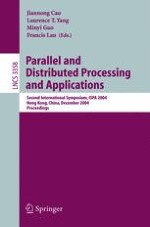Welcometotheproceedingsofthe2ndInternationalSymposiumonParalleland Distributed Processing and Applications (ISPA2004) which was held in Hong Kong, China, 13–15 December, 2004. With the advance of computer networks and hardware technology, parallel and distributed processing has become a key technology which plays an imp- tant part in determining future research and development activities in many academic and industrial branches. It provides a means to solve computati- ally intensive problems by improving processing speed. It is also the only - ableapproachtobuildinghighlyreliableandinherentlydistributedapplications. ISPA2004 provided a forum for scientists and engineers in academia and ind- try to exchange and discuss their experiences, new ideas, research results, and applications about all aspects of parallel and distributed computing. There was a very large number of paper submissions (361) from 26 countries and regions, including not only Asia and the Paci?c, but also Europe and North America. All submissions were reviewed by at least three program or technical committee members or external reviewers. It was extremely di?cult to select the presentations for the conference because there were so many excellent and interesting submissions. In order to allocate as many papers as possible and keep the high quality of the conference, we ?nally decided to accept 78 regular papers and 38 short papers for oral technical presentations. We believe that all of these papers and topics not only provide novel ideas, new results, work in progress and state-of-the-art techniques in this ?eld, but also stimulate the future research activities in the area of parallel and distributed computing with applications.
